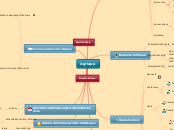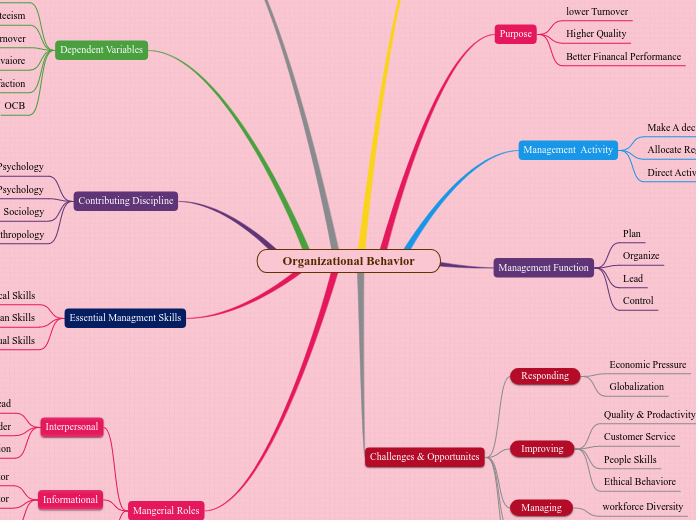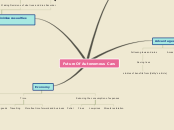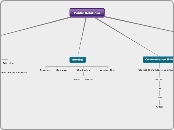Finish here
Finalising your map
Congratulations - you have reached the end of this Smart Map wizard.
You can return to this map again and use the Wizard to add more items if you need to. Just going through the process will probably generate some more ideas.
This map can then be saved as a regular Mindomo map, and used to communicate with your stakeholders. It can then become the basis for detailed planning and scheduling. There are more features in Mindomo that can help you with this.
If you have comments on this map, please feel free to add them in the comment panel on the right.
Start here
Welcome!
This Smart Map works by explaining the purpose of each area of the map, then helping you to input your information. Existing topics are populated and new ones created to describe your your project, initially within a predefined framework. Later on, you can amend and restructure it as you wish, using further Mindomo features.
Press Enter or click the right-arrow button below to continue.
Agriapp
Enter your project name
Begin by typing your project name into the Central Topic below, then press the Enter key or click the right-arrow button.
Risks & Issues
Risks and Issues
Projects of all sizes face risks and issues, which must both be proactively managed.
Risks are characterised by their probability, and their severity if they do occur. They can be controlled by reducing their probability and/or reducing the severity of their impact.
Issues need to be identified early and addressed early, otherwise they might become critical later and cause a delay.
Issue log
Issues Log
Issues are risks that have already occurred. Even if your project has not yet started, you might already know of some issues. It is good practice to maintain a log of current issues so that they do not get forgotten.
Issue
Add a project issue
Add a project issue and grade its impact by clicking an icon below:
- Currently blocking progress
- A workaround exists, but the solution is not known
- The solution is known but is not implemented
- Temporary issue that may solve itself
Action
Add an action for this issue
What action are you taking to address this issue? Add one or more actions.
Potential critical risk
Risk Log
The Risk Log contains the main risks that might affect the project outcome. This does not need to be highly detailed, nor should you include large-scale events such as earthquakes. Typical project risks include:
- Key people being unavailable when needed
- Specifications proving to be incomplete
- Work taking longer than planned
- Some new technology not working as expected
- Late delivery from a supplier
Depending on one server only would be risky. Any issue that might end on having the service down would have a huge impact. Back up service would be required.
Add a project risk
Add a project risk and grade its impact by clicking an icon below:
- High probability / high severity: control is essential
- Low probability / high severity: control is essential
- High probability / low severity: control is preferable
- Low probability / low severity: we may accept
Control
Add a control for this risk
Type in a short summary of what action you might be able to take to control this risk. Options include:
- Doing something to reduce the probability of occurrence
- Doing something to reduce the severity of impact if it does occur
- Having a contingency plan to follow if the event occurs
- Accepting the risk and living with it
Activities & Schedule
Project activities and schedule
Although we are not planning a detailed schedule here, this map should include the major work elements so that they can be broken down into tasks later.
Activity
Add a project activity
Type in a project activity. Examples include:
- Requirements collection and analysis
- Research and problem-solving
- Design and architecture
- Completing deliverables
- Acceptance testing and feedback
- Support and maintenance
Schedule
Add the timescale for this activity
When will this activity take place? Type an approximate date or a project stage.
Communications plan
Communications plan
Communications are vital to your project, so that all stakeholders know what they need to know to play their part. A communications plan helps you to keep everyone informed.
Key communications events
Key communications events
Your communications plan should include a number of key events, with specific purposes and outcomes. You can choose from the suggestion that follow or add your own.
Other event
Add another event
Add other project communications events not listed above, or press Enter to skip.
Project review
Include a project review?
The project review meeting takes place once the project has been closed, and examines the processes that led to both success and failure in the project. The goal of the review meeting is to improve processes and techniques for the next time.
Click the icon to include a project review meeting:
Close-out meeting
Include a close-out meeting?
The project close-out meeting confirms that the stakeholders are all satisfied with the outcomes of the project, and it can officially be accepted as complete.
Click the icon to include a close-out meeting:
Quality reviews
Include quality reviews?
If you have specific quality criteria to meet, or have a quality regime in your organisation, you may need to conduct periodic reviews to ensure that the project could pass an audit at any time.
Click the icon to include quality reviews:
Risk and issue reviews
Include risk and issue reviews?
You should periodically review project risks and issues, to ensure that new risks are not emerging, and that issues are not being left unaddressed.
Click the icon to include risk and issue reviews:
Progress reviews
Include progress reviews?
If the project is large enough or if you are using an Agile methodology, you will need regular progress reviews with a consistent agenda.
Click the icon to include progress reviews:
Stage planning
Include stage planning meetings?
If your project is large, or if you are using an Agile methodology, you may need regular planning meetings to schedule the project in stages.
Click the icon to include stage planning meetings:
Kick-off meeting
Include a kick-off meeting?
The project kick-off meeting ensures that the project team and key stakeholders all have the same goals, know what the main elements of the plan are, know what the processes and rules are, and know what part they will play.
Click the icon to include a kick-off meeting:
Communication and collaboration tools
Communication and collaboration tools
What communication and collaboration tools will you use? How will you issue bulletins, share documents and work collaboratively? Which tools will be suitable for your stakeholders?
De coste estimado me he inventado 5000E, no sabía q poner
Monday
Mindomo
Tricider
Drive
Physical meeting
E.mail
Add a communication tool
Add a communication / collaboration tool. Examples include:
- Physical meetings
- E-mail distribution lists
- Instant messaging and virtual meetings
- Local or cloud-based file sharing
- On-line project management tools
- On-line discussion boards
- Collaborative authoring tools
Requirements management
Requirements Management
Requirements often make or break projects. If the requirements are not well known in advance, the way that you handle this situation will have a significant impact.
Knowing the requirements is important, but it is more important to be in control of the requirements, and to know what is excluded as well.
Requirements Management
Requirements Management
How will you respond when requirements change? How will you keep track of changing requirements?
We agree to work as a team spending the same time
We commit to the project inside and outside the classroom
Add a requirements management technique
Add a technique or process to manage requirements. Techniques might include:
- Using a process for discovering requirements
- Maintaining a master list of requirements
- Writing testable and measurable requirements
- Establishing a formal process for agreeing changes to the requirements
- Verifying designs against requirements
Stakeholders
Project Stakeholders
A 'Stakeholder' is anyone who might be affected by the project or its outcomes. Some stakeholders are clear, for example the customer and users. But sometimes there are hidden stakeholders, such as people who share the resources that the project will also use. You will need a list of stakeholders for your communication plans.
Partners and suppliers
Partners and suppliers
Will you be working with any external partners or suppliers to deliver your project?
-
Add a partner or supplier
Add a partner or supplier. You can add their service or speciality in brackets after their name.
Project team
The project team
Your project team may consist of direct members and people who support the project in other ways.
André Thiebaut
Marc López
Anna MAgnusdottir
Carla Fruchet
Pau Subietas
Add a team member
Add a team member. You can add their role in brackets after their name. Examples include:
- Project managers
- Core team members, who stay with the project from beginning to end
- Extended team members, who help only when needed
- Specialists and experts
- Support services and administrators
Users
Users
The users of the outcome of your project may not be the same as the customers who pay the bill. Who are the users, and who represents their interests on the project?
Retailers CPOs
Farmers
Add a user
Add a user or user representative, such as:
- Typical users
- People who represent groups of users
- People who will be testing your product or project
Customers
Customers
Who are the people in the customer's organisation who are important to the project?
3rd sector companies (Retailers).
Farmers and agrarians
Add a customer representative
Add a customer representative. These might include people who:
- Define and agree requirements
- Monitor progress
- Resolve issues
- Accept deliverables
Sponsors
Project sponsors
Project sponsors are the senior members of your organisation who are backing (or will need to be persuaded to back) your project. They provide the authority for the project.
Sponsor
Add a project sponsor
Add a name and press Enter.
Business Case
The Business Case
The Business Case justifies the investment in the project. If your project is already approved, then you can skip over this section and delete it later. But if you need buy-in for your project, then you may need to make a simple business case.
Strategic fit
Strategic 'fit'
How well does this project fit your strategy?
Is it 'strategic'?
Does it help you along the road towards strategic goals, either for your team, department or company?
Justification
Add a strategic reason
Add a strategic reason for this project.
Key benefits
Key benefits
What are the key benefits to your organisation in taking this project forward?
Improving communication between sectors with TIC networks
Gaining a competitive advantage from a non-exploited market
Add a key benefit
Type in a key benefit from this project. Examples include:
- Creating new opportunities
- Gaining a competitive advantage
- Solving a key problem
- Developing new knowledge
Estimated costs
Estimated costs
Estimated costs will help to determine the level of authorisation required, the cost/benefit ratio, and the opportunity costs of the project.
5000E - Develop the idea
Add an estimated cost
Type in the name of a cost and the estimated amount. Typical costs include:
- Internal staff costs
- Contracted labour costs
- Outside services
- Capital costs and materials
- Opportunity costs - what else will not be done
Statement of Work
The Statement of Work
The first thing to write is the Statement of Work. This gives a high-level overview of the major items that the project should deliver.
Subtema
Assumptions
Project assumptions
What assumptions are you making in order to deliver this project successfully?
What is outside your control, or is on your list to'deal with later'?
Easy use of the technology
Resources available
Add an assumption
Type an assumption into the topic text. Examples include:
- Resources will be available
- Technology will work reliably
- Materials costs will stay the same
- Another project will finish on time
Resources
Project resources
What are the key resources that this project will need?
Initial investment
Long term finance
Services and expertise
People
Add a project resource
Add a key resource that your project will need. Examples include:
- People
- Equipment
- Materials
- Services and expertise
- Short term finance or capital investment
Milestones
Milestones
A project milestone is an event that shows progress along the path towards completion. Milestones usually have deadline dates.
Sell the idea
6th week
Summary
5th week
Prototyping
4th week
Survey Typeform
Market research
2nd week
Project decission
Add a project milestone
Type in the name of a milestone for your project. Examples include:
- A strategic decision
- Signing an agreement
- A key meeting
- Acceptance of a deliverable
1st week
Add a milestone date
Enter an approximate target date for this milestone.
You can return later to customise the task information in this Mindomo map and start using its project management features.









